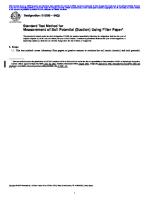Fall-of-Potential Graph: Figure 7 - Typical Impedance Versus Potential Probe Spacing For Fall-Of-Potential Method [PDF]
IEEE Std 81-2012 IEEE Guide for Measuring Earth Resistivity, Ground Impedance, and Earth Surface Potentials of a Groundi
47 1 496KB
Papiere empfehlen
![Fall-of-Potential Graph: Figure 7 - Typical Impedance Versus Potential Probe Spacing For Fall-Of-Potential Method [PDF]](https://vdoc.tips/img/200x200/fall-of-potential-graph-figure-7-typical-impedance-versus-potential-probe-spacing-for-fall-of-potential-method.jpg)
- Author / Uploaded
- mehran
Datei wird geladen, bitte warten...
Zitiervorschau
IEEE Std 81-2012 IEEE Guide for Measuring Earth Resistivity, Ground Impedance, and Earth Surface Potentials of a Grounding System
grid with an interconnected shield and neutral systems), such a representation is extremely difficult to obtain.
Fall-of-Potential Graph 4.5 Impedance (ohms)
4 3.5 3 2.5 2 1.5 1 0.5 0 0
30
60
90
120
PP distance from ground (m) PP in same direction as CP
PP in opposite direction from CP
Figure 7 —Typical impedance versus potential probe spacing for fall-of-potential method Dr. G. F. Tagg [B58] described a method known as the “slope method.” In his method, the assumptions of uniform soil resistivity and representation of the grounding electrode system as an equivalent hemispherical electrode remained as before. However, his method allowed measuring the probe distances from a convenient point such as from the edge of a grounding electrode system by introducing the error distances in the fall-of-potential equation. Dr. Tagg’s slope method [B58] can be summarized as follows: a) Choose a convenient starting point for linear measurements and select a suitable distance for the CP. b) Measure resistances R1, R2, and R3 by inserting PPs at 0.2CP, 0.4CP, and 0.6CP distances, respectively. c) Calculate the slope-variation coefficient μ = (R3 – R2) / (R2 – R1). d) Look up the value of PPT/CP corresponding to the “μ” value in Table 5. e) Measure the resistance by placing the potential probe at PPT distance.
24 Copyright © 2012 IEEE. All rights reserved.
Authorized licensed use limited to: York University. Downloaded on June 25,2014 at 04:38:47 UTC from IEEE Xplore. Restrictions apply.
IEEE Std 81-2012 IEEE Guide for Measuring Earth Resistivity, Ground Impedance, and Earth Surface Potentials of a Grounding System
Table 5 —Slope method coefficients [B58] μ
PPT/CP
μ
PPT/CP
μ
PPT/CP
0.40 0.41 0.42 0.43 0.44 0.45 0.46 0.47 0.48 0.49 0.50 0.51 0.52 0.53 0.54 0.55 0.56 0.57 0.58 0.59 0.60 0.61 0.62 0.63 0.64 0.65 0.66 0.67 0.68 0.69 0.70 0.71 0.72 0.73 0.74 0.75 0.76 0.77 0.78 0.79
0.643 0.642 0.640 0.639 0.637 0.636 0.635 0.633 0.632 0.630 0.629 0.627 0.626 0.624 0.623 0.621 0.620 0.618 0.617 0.615 0.614 0.612 0.610 0.609 0.607 0.606 0.604 0.602 0.601 0.599 0.597 0.596 0.594 0.592 0.591 0.589 0.587 0.585 0.584 0.582
0.80 0.81 0.82 0.83 0.84 0.85 0.86 0.87 0.88 0.89 0.90 0.91 0.92 0.93 0.94 0.95 0.96 0.97 0.98 0.99 1.00 1.01 1.02 1.03 1.04 1.05 1.06 1.07 1.08 1.09 1.10 1.11 1.12 1.13 1.14 1.15 1.16 1.17 1.18 1.19
0.580 0.579 0.577 0.575 0.573 0.571 0.569 0.567 0.566 0.564 0.562 0.560 0.588 0.556 0.554 0.552 0.550 0.548 0.546 0.544 0.542 0.539 0.537 0.535 0.533 0.531 0.528 0.526 0.524 0.522 0.519 0.517 0.514 0.512 0.509 0.507 0.504 0.502 0.499 0.497
1.20 1.21 1.22 1.23 1.24 1.25 1.26 1.27 1.28 1.29 1.30 1.31 1.32 1.33 1.34 1.35 1.36 1.37 1.38 1.39 1.40 1.41 1.42 1.43 1.44 1.45 1.46 1.47 1.48 1.49 1.50 1.51 1.52 1.53 1.54 1.55 1.56 1.57 1.58 1.59
0.494 0.491 0.488 0.486 0.483 0.480 0.477 0.474 0.471 0.468 0.465 0.462 0.458 0.455 0.452 0.448 0.445 0.441 0.438 0.434 0.431 0.427 0.423 0.418 0.414 0.410 0.406 0.401 0.397 0.393 0.389 0.384 0.379 0.374 0.369 0.364 0.358 0.352 0.347 0.341
25 Copyright © 2012 IEEE. All rights reserved.
Authorized licensed use limited to: York University. Downloaded on June 25,2014 at 04:38:47 UTC from IEEE Xplore. Restrictions apply.
IEEE Std 81-2012 IEEE Guide for Measuring Earth Resistivity, Ground Impedance, and Earth Surface Potentials of a Grounding System
I V
E
p1
P
x
C
h
p2 d
K= 0.95 0.80 0.60 0.40 0.20
RATIO x/d IN %
80 70
K-0.0
60
-0.20 -0.40 -0.60 -0.80 -0.95
50
10 -4
p2 - p1 K= p p 2 + 1
10 -2
10 0
10 2
10 4
RATIO h/d
Figure 8 —Required potential electrode position in a two layer earth 8.2.2.4.1 Interpretation of the results In the case of the fall-of-potential method for a given current probe location, there is one potential probe spacing that gives the true ground impedance of the ground being tested. However, the correct spacing can be very difficult to determine, especially if the ground grid has a complex shape (see Curdts [B18], Dawalibi and Mukhedkar [B20], and Dawalibi and Mukhedkar [B22] for additional information). The correct spacing is also a function of the soil configuration, as demonstrated in Dawalibi and Mukhedkar [B20] and illustrated by Figure 8, which is applicable to small ground systems. As indicated in Figure 8, the required potential probe spacing x (when the probe is between E and C and when the soil is uniform) is such that the ratio x/d = 0.618. This was first proved by Curdts [B18] for small hemispherical electrodes. See Annex C. The preceding statements show that to apply the 62% rule, the following conditions need to exist: a)
A fairly uniform soil.
26 Copyright © 2012 IEEE. All rights reserved.
Authorized licensed use limited to: York University. Downloaded on June 25,2014 at 04:38:47 UTC from IEEE Xplore. Restrictions apply.









